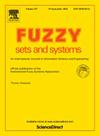具有连续相加生成器的同构三角子矩阵
IF 3.2
1区 数学
Q2 COMPUTER SCIENCE, THEORY & METHODS
引用次数: 0
摘要
加法生成器在 t-(子)规范的构造中起着重要作用。与 t 准则不同的是,t-子准则的加法发生器不一定是严格递减的,而且在 1 处的值也不一定是 0。本文给出了两个由连续加法发生器生成的 t-子准则同构的充分必要条件。本文章由计算机程序翻译,如有差异,请以英文原文为准。
Isomorphic triangular subnorms with continuous additive generators
The additive generators play an important role in the construction of t-(sub)norms. Distinct to t-norms, the additive generators of t-subnorms need not be strictly decreasing and the value at 1 need not be 0. This paper gives the sufficient and necessary conditions such that two t-subnorms, generated by continuous additive generators, are isomorphic.
求助全文
通过发布文献求助,成功后即可免费获取论文全文。
去求助
来源期刊

Fuzzy Sets and Systems
数学-计算机:理论方法
CiteScore
6.50
自引率
17.90%
发文量
321
审稿时长
6.1 months
期刊介绍:
Since its launching in 1978, the journal Fuzzy Sets and Systems has been devoted to the international advancement of the theory and application of fuzzy sets and systems. The theory of fuzzy sets now encompasses a well organized corpus of basic notions including (and not restricted to) aggregation operations, a generalized theory of relations, specific measures of information content, a calculus of fuzzy numbers. Fuzzy sets are also the cornerstone of a non-additive uncertainty theory, namely possibility theory, and of a versatile tool for both linguistic and numerical modeling: fuzzy rule-based systems. Numerous works now combine fuzzy concepts with other scientific disciplines as well as modern technologies.
In mathematics fuzzy sets have triggered new research topics in connection with category theory, topology, algebra, analysis. Fuzzy sets are also part of a recent trend in the study of generalized measures and integrals, and are combined with statistical methods. Furthermore, fuzzy sets have strong logical underpinnings in the tradition of many-valued logics.
 求助内容:
求助内容: 应助结果提醒方式:
应助结果提醒方式:


